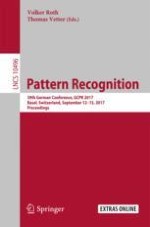This book constitutes the refereed proceedings of the 39th German Conference on Pattern Recognition, GCPR 2017, held in Basel, Switzerland, in September 2017.The 33 revised full papers presented were carefully reviewed and selected from 60 submissions. The papers are organized in topical sections on biomedical image processing and analysis; classification and detection; computational photography; image and video processing; machine learning and pattern recognition; mathematical foundations, statistical data analysis and models; motion and segmentation; pose, face and gesture; reconstruction and depth; and tracking.
